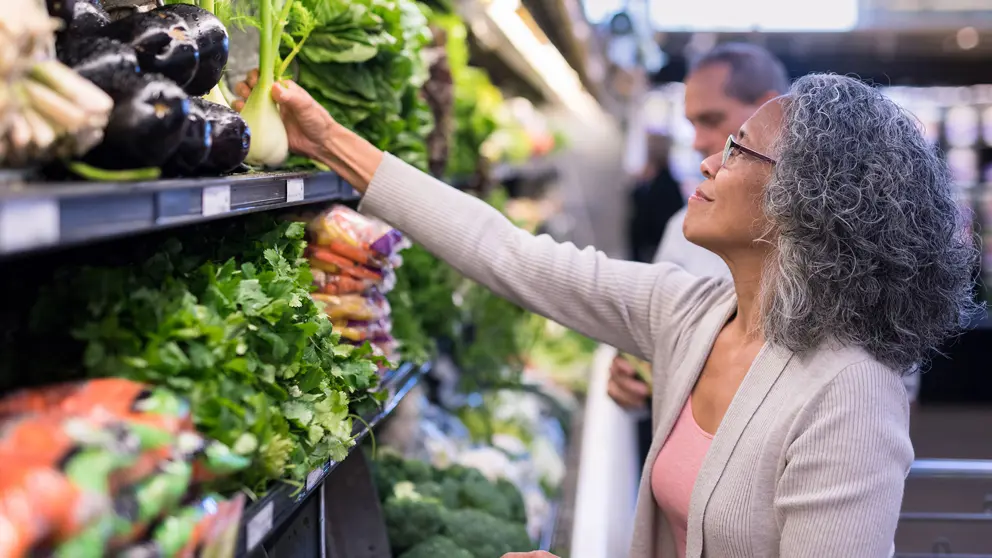Food inflation has hit Canada in a big way. Grocery prices jumped by over 10% since September 2021. For the average family of four, that means an increase of almost $1,065 per year in grocery spending.
In 2023, food inflation is projected to trend around 7%. More than ever, it’s important to learn tips and tricks that will shave a few dollars off your grocery bill. Here’s a guide to saving money at the supermarket.
Before you shop
Make a list. It’s obvious but always wise. A list will ensure you don’t spend too much on impulse purchases and avoid duplicating what’s already in your fridge and pantry. Find inspiration here for nutritious and economical meal ideas.
Rescue some healthy food. Check what’s available at discounted cost from food rescue apps such as Too Good To Go, Flashfood and Food Hero. Food rescue apps connect consumers to surplus food from restaurants, cafes and grocery stores at discounted prices. Rescuing food saves you money and helps reduce waste. Savings can be about 50% on end-of-day restaurant food and soon-to-expire groceries.
Work the points. Sign up for grocery store loyalty programs that offer discounts or cash back on purchases, such as Air Miles (Metro), Optimum (Loblaws), Scene+ (Sobeys/Safeway) or
More Rewards (Save-On Foods). Download the program app and follow instructions to begin saving. You can also set up a “cash-back account” on an app such as Drop, KOHO, Caddle, Ampli, Paymi, or Checkout 51.
Scan flyers and use coupons. A sure-fire money saver is to find the best price on products you need by scanning flyers online. Websites include save.ca, websaver.ca, canadianfreestuff.com and smartcanucks.ca. If you prefer smartphone apps, here are some to try: Flipp, Swagbuck, Reebee and Caddle. You can browse weekly digital flyers or coupons, or search for the items you need and see if they are on sale anywhere. Some flyer apps even pair with loyalty cards, so you can add product coupons right into your loyalty app.
Price match. Some retailers (such as Food Basics and NoFrills) will match the advertised price at a competing store, so it’s worth reviewing flyers even if a certain retailer isn’t your go-to store. Just show the flyer price to staff at customer service and see if their store will match it.
BYO bags. Most stores now charge for bags, so you can save a few cents (and help the environment) by using your own.
While you shop
Target sales, not “specials.” Remember that “special” may just mean a promotion or display of a certain product (like potato chips before Superbowl Sunday). It may look appealing, but check the price before you buy.
Look high and low. Food manufacturers pay listing fees to get their products on grocery store shelves. Most brands want to be placed at eye level to catch consumer attention. This means you’ll often find lesser known — and better priced — brands on higher or lower shelves.
Go generic. Choose generic or “no name” brands to save. They’re often made by the same food manufacturers that make the recognized brands, but sell at a fraction of the price. The calculator in your smartphone can help you compare price per unit on shelf tags (such as $1.98 per 100 grams), so you can make wise choices.
Share and save. Articles about saving money often encourage shoppers to buy in bulk, but what if the big package is beyond your budget? Consider shopping with friends or relatives, so you can buy in bulk and split the cost.
After you shop
Check your receipt. Sometimes you may be charged twice for a product, or a wrong code may be accidentally used. Refunds are available at customer service.
Store food smartly. Put your groceries in the right place to ensure they stay fresh longer, and to reduce waste. For example, if you bought chicken thighs but won’t be cooking them until next week, freeze them to preserve freshness. Learn more about safe food storage.
- Browse our heart healthy recipes for economical meal ideas.

